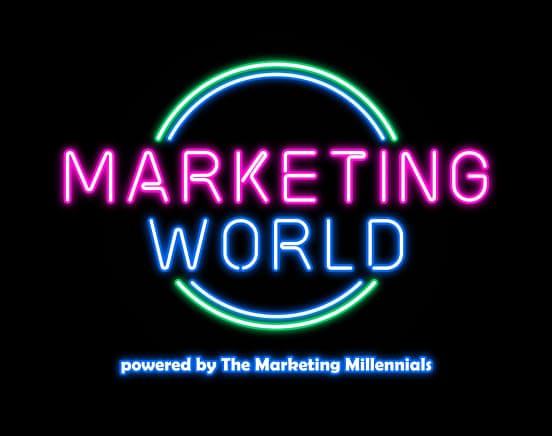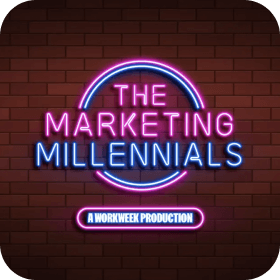I can’t hold my excitement for today’s guest, Cassie Petrey.
Co-founder of Crowd Surf, a social media marketing and music management firm, Cassie has experience working with some of the biggest names in entertainment, like Britney Spears.
Okay I wasn’t going to spill the beans on who she has worked with, but I had to LOL I’m a Britney stan.
Cassie shared all the wisdom that landed her on the Forbes’ 30 Under 30 list, on The Marketing Millennials Podcast.
Here’s what she had to say in her own liiiightly edited words.
1. You Need to Know This When Creating Content:
“Humans have historically been positioned to be sitting on a couch consuming content, whether it’s the radio, newspaper, or TV, we’re primed to sit for a longer period of time to consume.
But more people have been consuming content on phones and on the go, leading to the rise of short form content.
(Or if you’re like Ari and I, we watch TikTok’s on the couch while the TV is playing in the background LOL.)
Video is always going to be informed by what media devices are in our lives.
So when you’re creating content that’s visual, it’s always important to think about where do you envision somebody watching this? Is it going to be on Hulu? Is it going to be on TikTok? Is it going to be a photo that’s on Instagram?
You have to think about not just what you want people to see, but where they’re going to see it.
And that should inform the production and creative decisions you make.
2. Short and Long Form Videos Need This:
Whether you’re creating short or long form videos there has to be a story, a beginning, middle, and end.
Even when TikToks were all 10 seconds, you still needed to have a point you were making.
You need a thought process and you have to think about the emotion you want people to feel when they’re consuming your content.
What makes really good short form content is authenticity, especially content that’s being made on the go in real time (for TikTok ESPECIALLY).
Level up your marketing game
Zero BS. Just fun, unfiltered, industry insights with the game-changers behind some of the coolest companies from around the globe.
No spam. Unsubscribe any time.
And by authentic I mean, did the person who made that piece of content make it because they wanted to make it or because they had to make it? People can feel the difference now, especially when it’s a smaller production.
Through a phone people can feel your intention and if you’re doing something for likes or because you want to entertain or help people, it comes down to being authentic.
In terms of long form content, authenticity is still important, but long form is more screen time and needs more planning.
Even if you’re making a vlog of your day, you still need a shot list, you need to have a plan for editing.
I was lucky enough to watch Jake Paul when he was doing daily vlogs, he would make a YouTube video every single day. The videos looked so unplanned but there was a high level of planning (the best of the best make the hardest tasks look effortless).
They would block off a part of his day for shooting and he would make voice notes as he was shooting to send to the editor so they would know what to do.
And even more innovative was that they used an editor in the UK, so they would make the video during the day and it would get sent to the editor.
They were using time zones to their advantage, they’re editing while you’re sleeping, so the content is ready to go in the morning (this is freakin genius).
Everything needs a plan, even if it’s short, but the longer the video the more planning you’re going to have to do.
3. Stop Using the Word Influencer:
People who have influence generally don’t set out to have influence.
If that is your goal, that’s an equivalent to saying I want to be a dictator, I want people to like me and do what I say.
That’s not coming from a good place. Don’t get me wrong, you can have some success on that path for a little while, but it’s not something that’s sustainable long term.
If somebody wants to “influence”, I like to replace that word with help (this is my new fav thing).
How do I help people? How do I provide value to the world? By helping people and providing value to the world, you make somebody’s day better or you make somebody not feel alone in an emotion they have.
That’s all influencing, but that has really good intentions behind it.
It all comes down to why do you want to “influence”?
I recently stopped working with an artist that I was managing because when I would ask that question, they would just say, “I want to be a pop star.”
That’s not a good enough reason to do this.
Sometimes it feels like you just want Instagram likes and views, but that’s not the right reason to “influence”.
It’s a hard high to sustain if that’s your motivation because you can’t control likes, but you can control the content you’re putting out. You can control the issues that you support and the actions you take to help those issues.
4. How to Crush Influencer Partnerships:
The influencer partnerships that have performed the best are the ones with the least amount of restrictions on the influencer.
I get everyone’s inhibitions, a brand’s obviously paying for it, they should have some say in the outcome.
But I think the less say they can have and let go of control a little bit and let the influencer do their thing, the better off the content will be.
The influencer wouldn’t have that many followers if they weren’t smart, or had some expertise in their niche (so trust them!!).
5. The Key to Early Growth on Socials:
I love being an early adopter of new tools or social media platforms. There is such a massive advantage to it.
The downside could be that you spent time using a new tool or creating content or joining a platform that didn’t have an audience yet.
But the upside is so huge if that platform succeeds.
A lot of the biggest, most-followed people on TikTok are in that position because they were some of the first people on the platform (the TRUTH).
A lot of the most followed people on Twitter, especially at the beginning, were the most followed because they were the first people there and weren’t afraid to use a tool before it was widely accepted.
The biggest winners in social media are the ones who are open to trying a new tool that has potential and being okay if it doesn’t work.”



